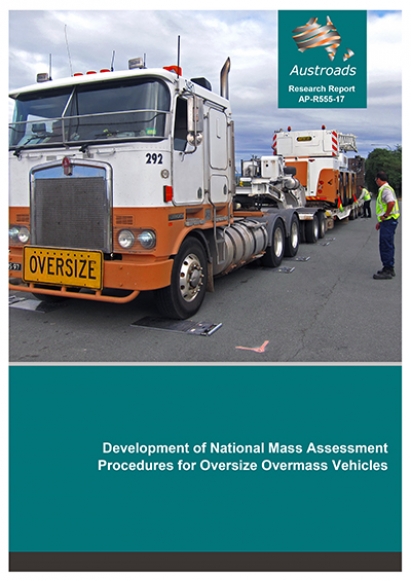Wednesday, 8 November 2017
Austroads has published draft guidelines for the weighing of oversized and overmass (OSOM) vehicle combinations using portable scales.

The existing Austroads guidelines for weighing heavy vehicles do not address the weighing of OSOM vehicles and this project aimed to develop a nationally-consistent procedure for assessing the mass of OSOM vehicles and develop Mass Measurement Adjustment (MMA) factors applicable to OSOM vehicles.
The report describes the conduct of field trials involving repeated weighing of four different OSOM vehicle combinations and analysis to determine the level of accuracy to be expected during roadside inspections.
Testing was conducted at a roadside inspection site on the east-bound carriageway of the Cunningham Highway at Yamanto, Queensland. The site was surveyed to determine the location of suitable areas of pavement that complied with Austroads requirements for Category 1, 2 and 3 weighing sites, where Category 1 is effectively flat and Categories 2 and 3 involve progressively steeper longitudinal and transverse grades.
The Port of Brisbane inbound weighbridge was used to obtain the reference vehicle mass and to investigate the potential sources of variations in the measurements.
Four vehicle combinations were used in the field tests:
- 2x4 dolly and 4x4 low loader with mechanical load-sharing suspension
- 2x4 dolly with mechanical suspension and 4x4 low loader with hydraulic load-sharing suspension
- 2x8 dolly with no suspension, 4x8 low loader with hydraulic load-sharing suspension
- 6x8 load platform with hydraulic load-sharing suspension.
All four trailer combinations were hauled by 6x4 prime movers.
The weighing methods for all combinations were:
- weighbridge (Port of Brisbane inbound)
- fully-blocked – scales under some axles, blocks of scale height under all other wheels of all vehicle units
- partially-blocked – scales under some axles, scales or blocks of scale height under other wheels of the same vehicle unit, wheels of other vehicle units on the ground
- unblocked – scales under some axles, other wheels on the ground.
The tests were conducted to collect data on the repeatability and consistency of the weighing methods and showed:
- The fully-blocked method produced results closest to the weighbridge reference values for all combinations. This was because placing all axles at the same vertical displacement relative to the chassis (i.e. fully‑blocked) minimised the load shift between axles, resulting in more consistent results across successive weighing operations.
- The partially-blocked method showed the second closest results to the weighbridge after the fully‑blocked method.
- The unblocked method produced higher readings than the weighbridge, with the discrepancy sometimes exceeding 10 tonnes for the overall combination, depending on the type of suspension on the vehicle.
- It was observed that the number of moves taken to weigh a combination did not contribute to a significant variation in the results; rather, the weighing method (fully-blocked, partially-blocked or unblocked) had a greater influence on results.
- Variant B of unblocked weighing of axles or groups resulted in higher readings on the scales and lower readings on the unblocked axles. This led to a much higher overall combination mass when readings were aggregated.
The calculations of the MMAs were based on the difference between the fully-blocked and partially‑blocked readings and the weighbridge readings. The MMAs were calculated to account for the likely spread of scale readings, such that all scale readings should be reduced to a value no higher than that obtained from a weighbridge. Due to the unpredictability of results identified in the unblocked weighing methods, no MMAs were produced for unblocked weighing.
The proposed MMAs are to be applied to OSOM vehicles only and are an addition to the existing set of MMAs used for conventional vehicles and axle groups.
Guidelines have been developed based on the test plan implemented during the field trial. They include suggestions on weighing the combination when using several long scales, short scales and blocks. However, these guidelines are not exhaustive and will require input from experienced on-road staff on how best to apply them to other vehicle configurations.
Report link: Development of National Mass Assessment Procedures for Oversize Overmass Vehicles
Webinar: Join co-authors Anthony Germanchev and Philip Roper for an online overview of the guidelines on 12 December 2017. No charge but registration essential. Register now!
